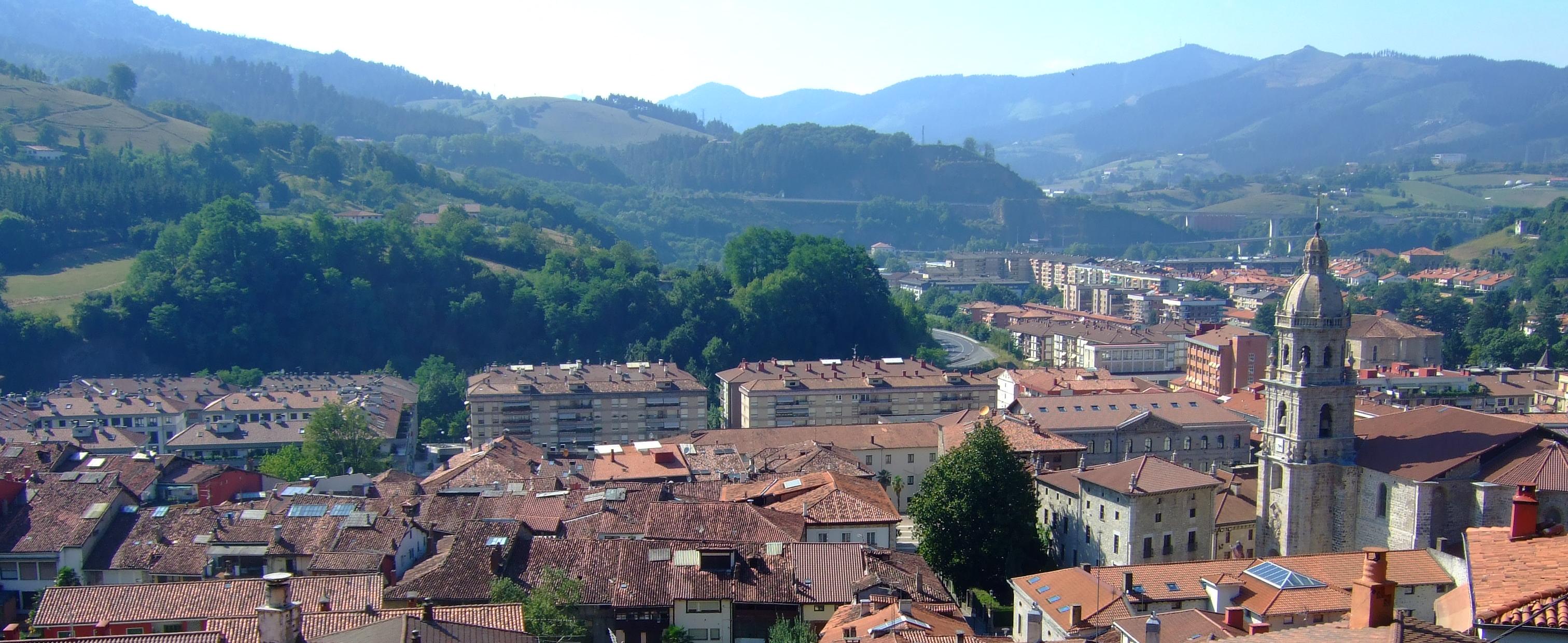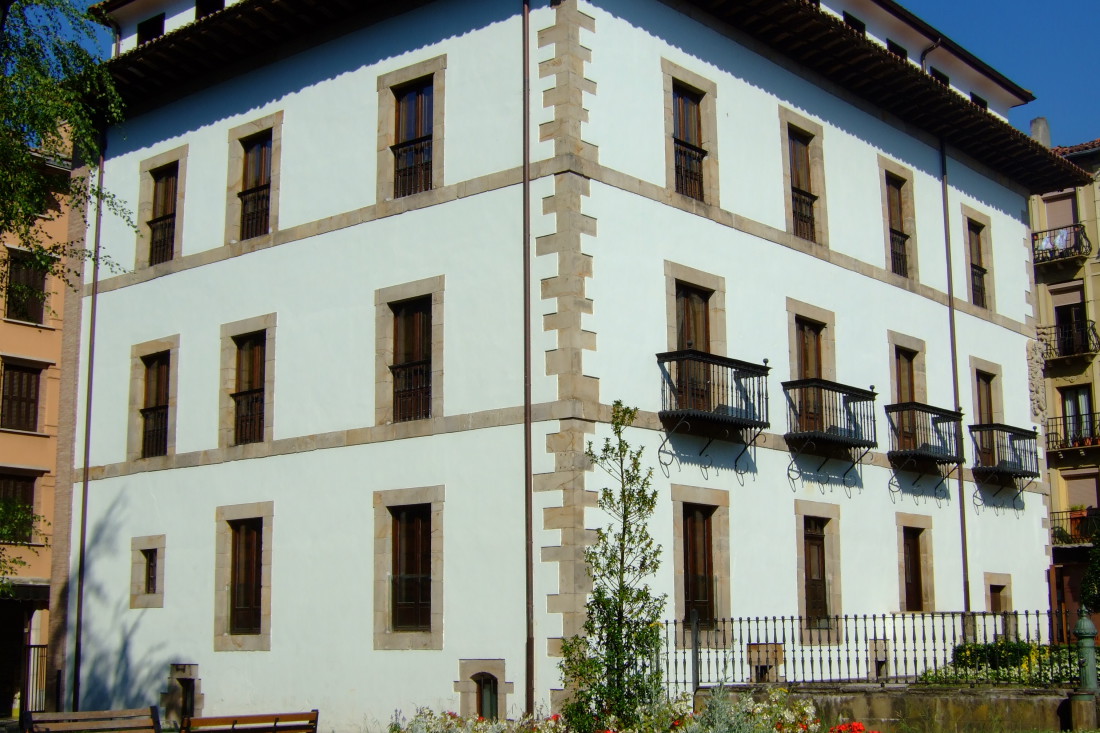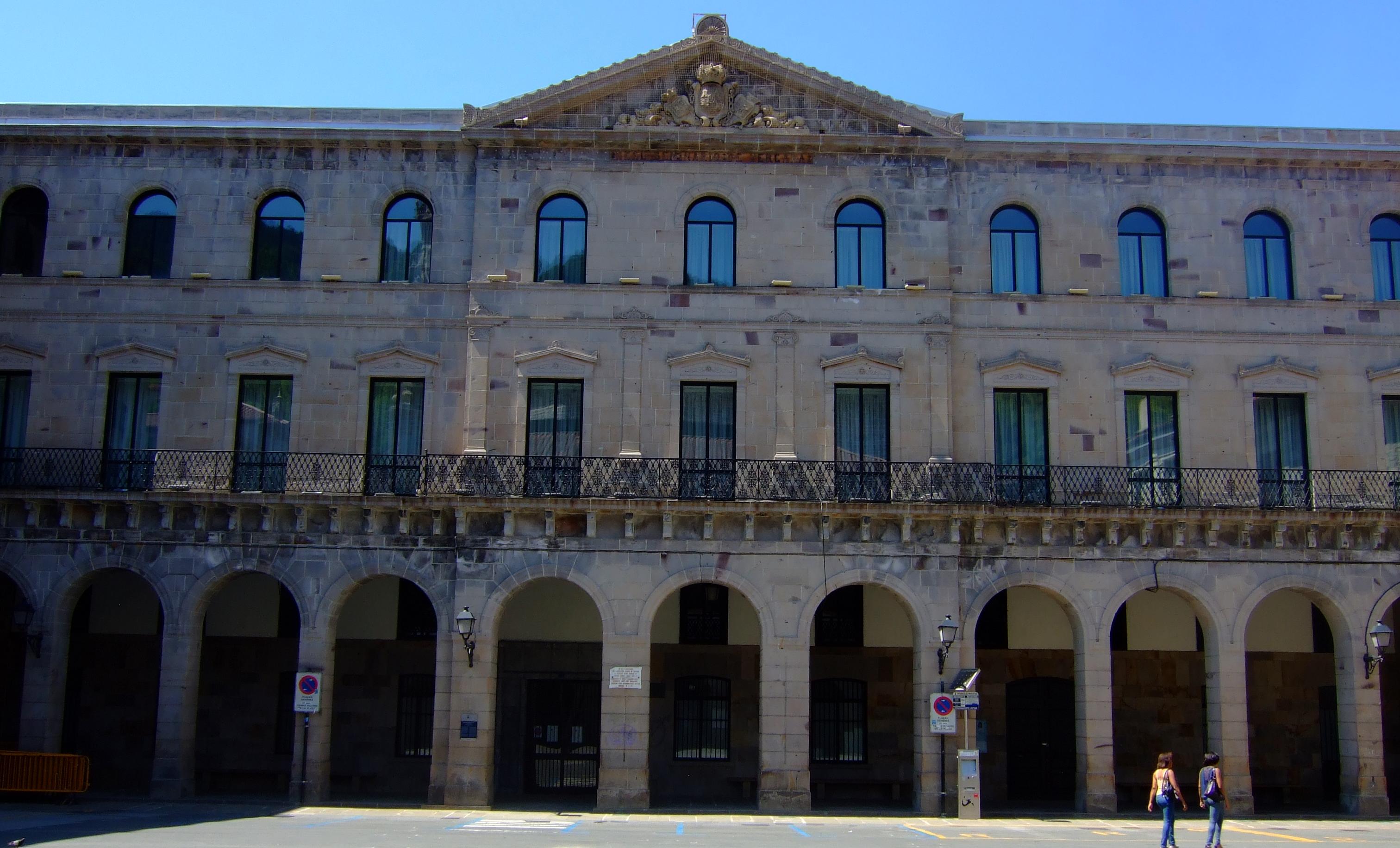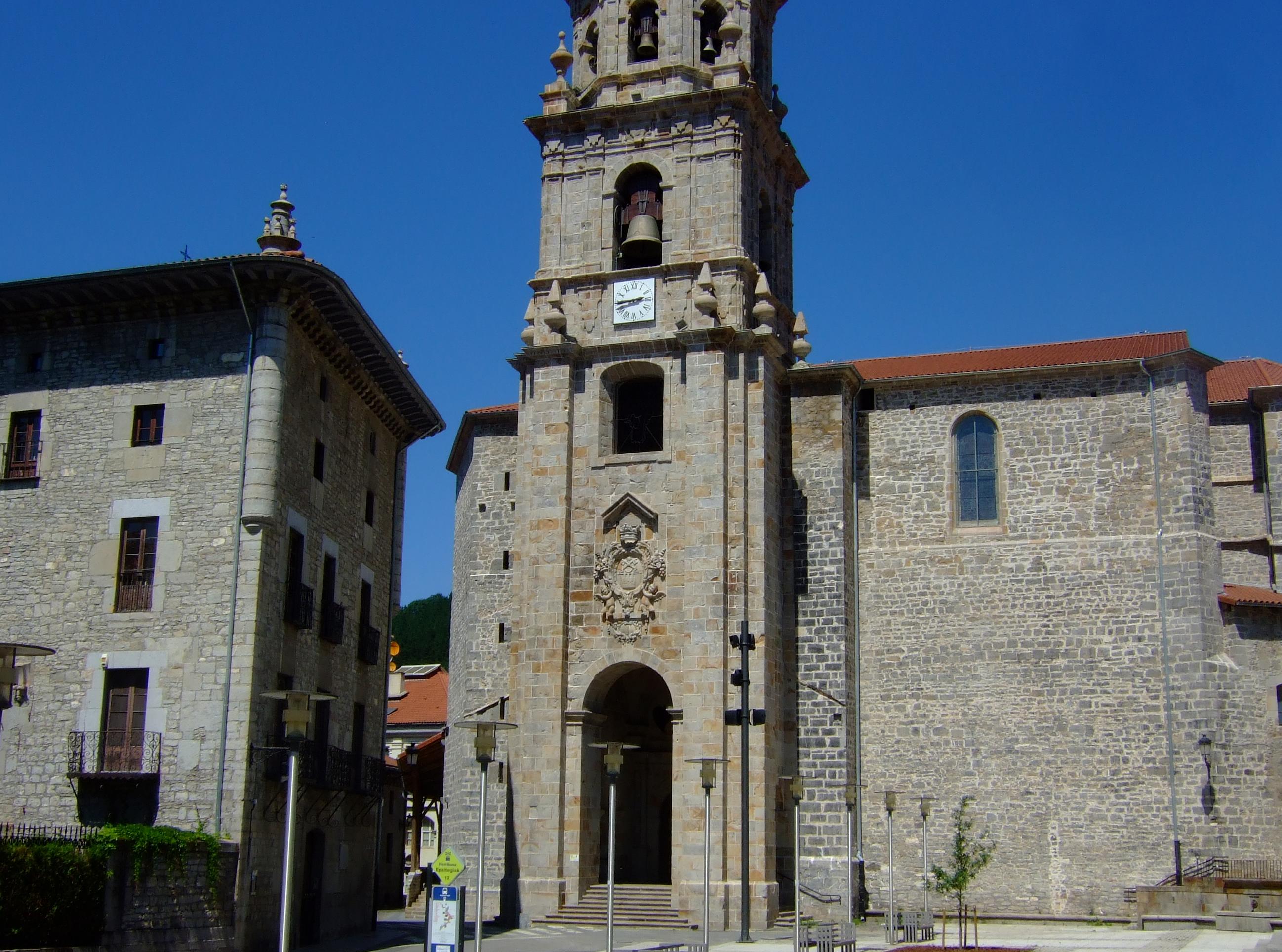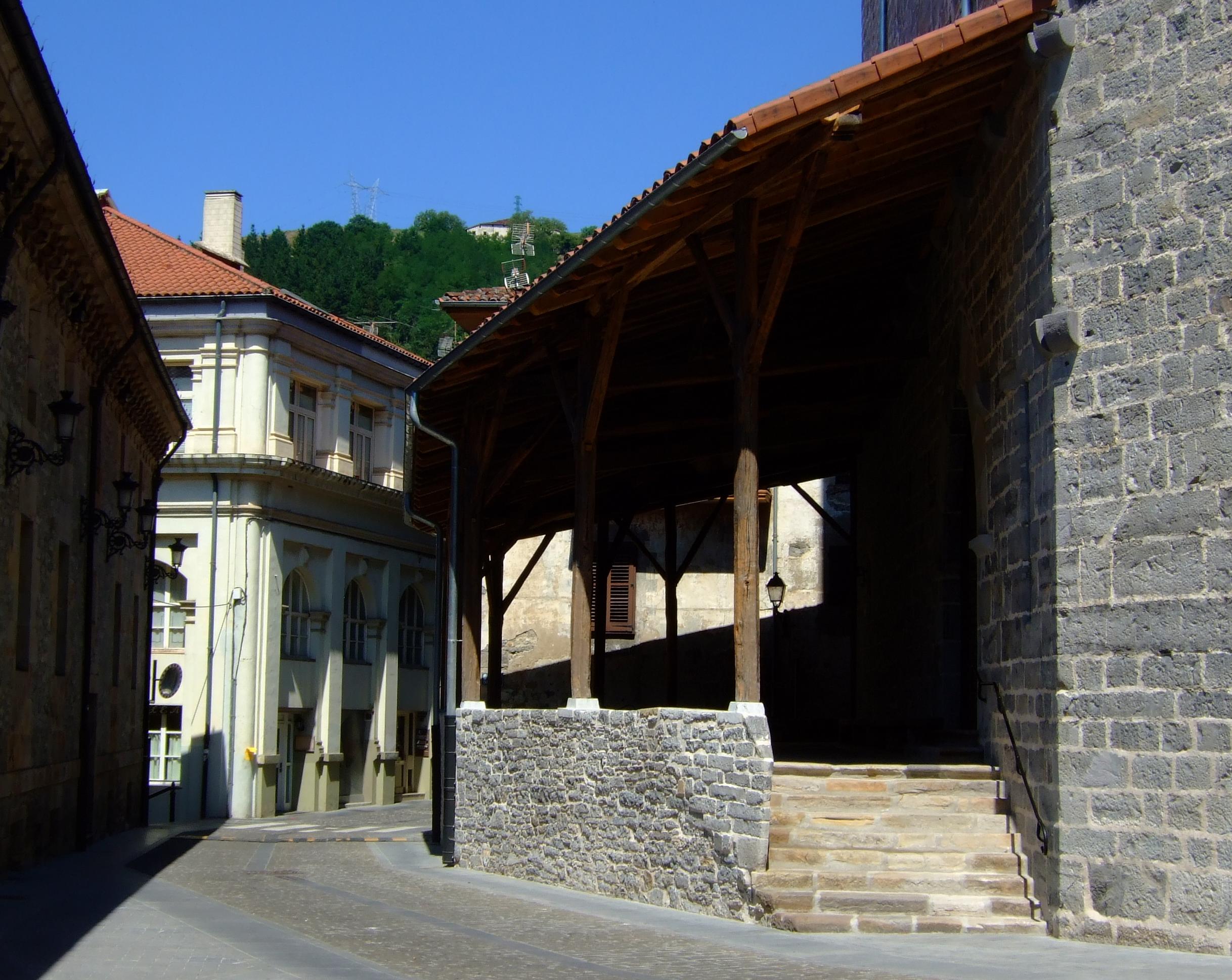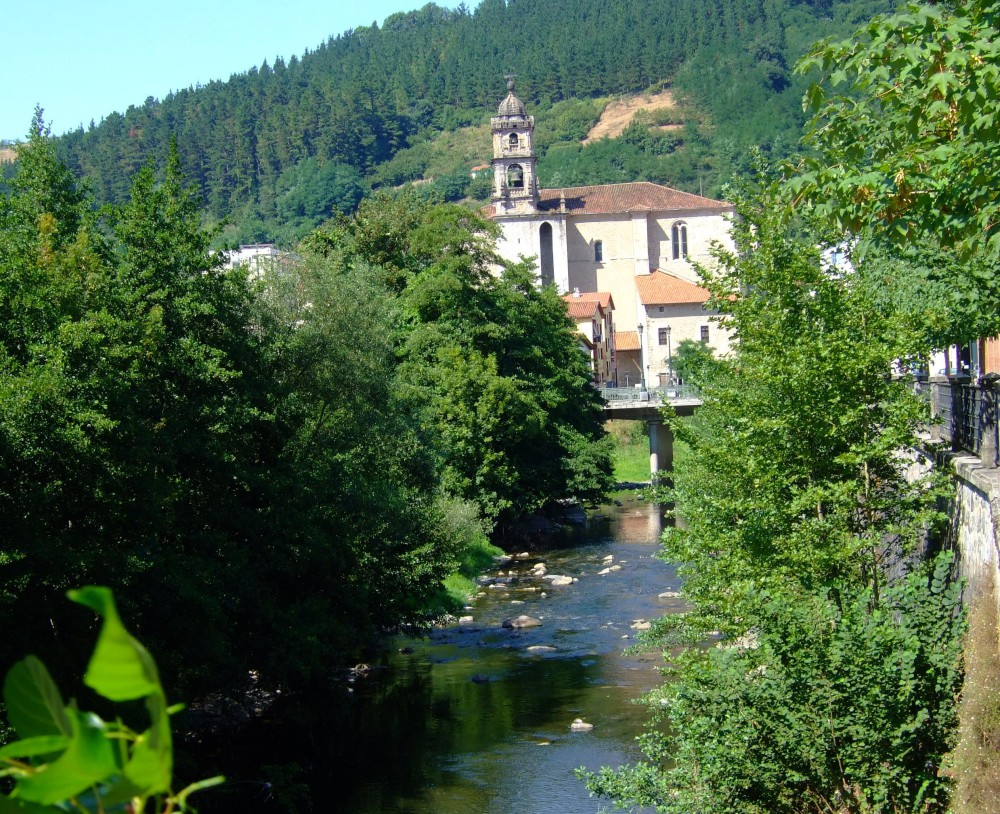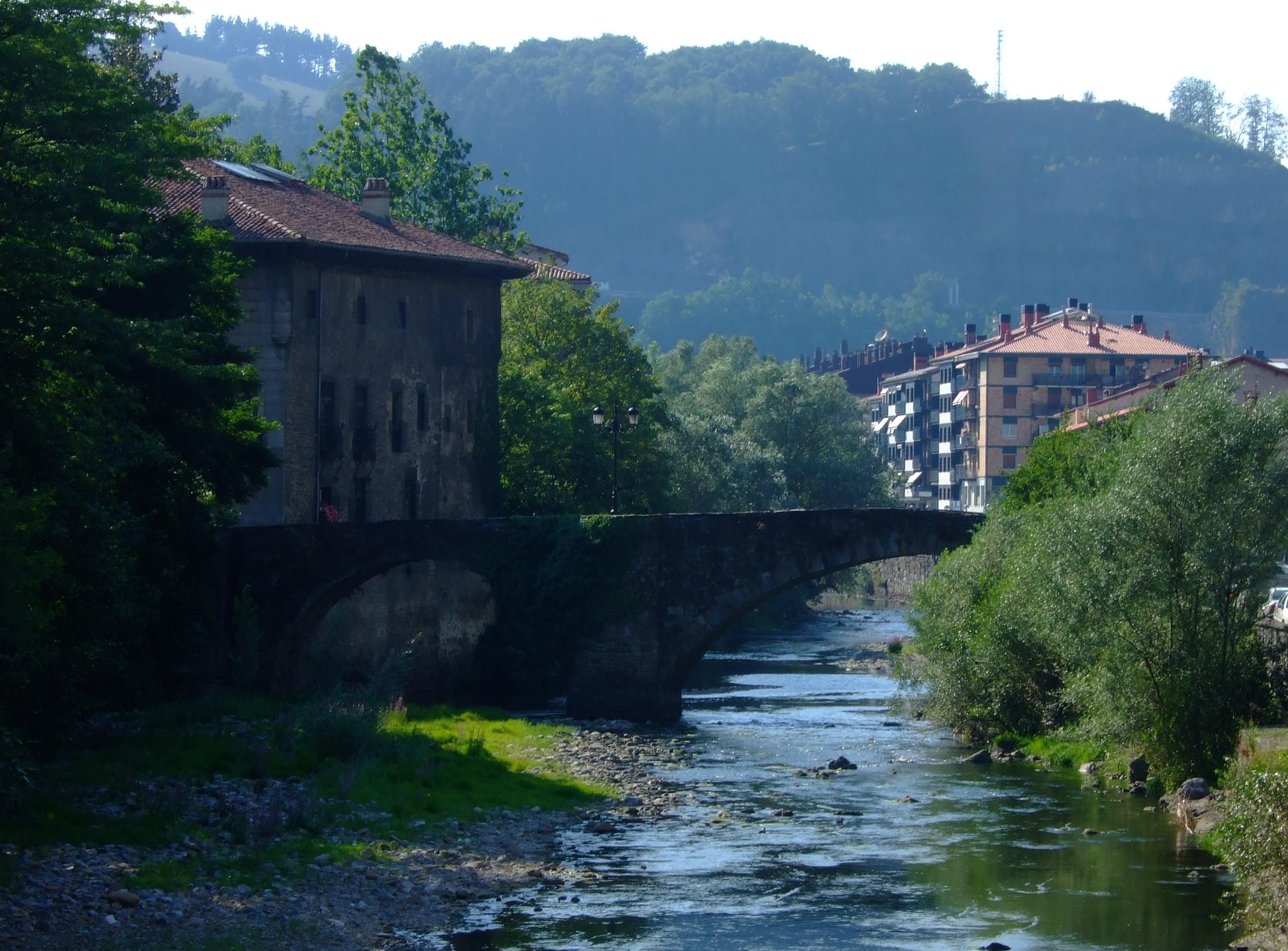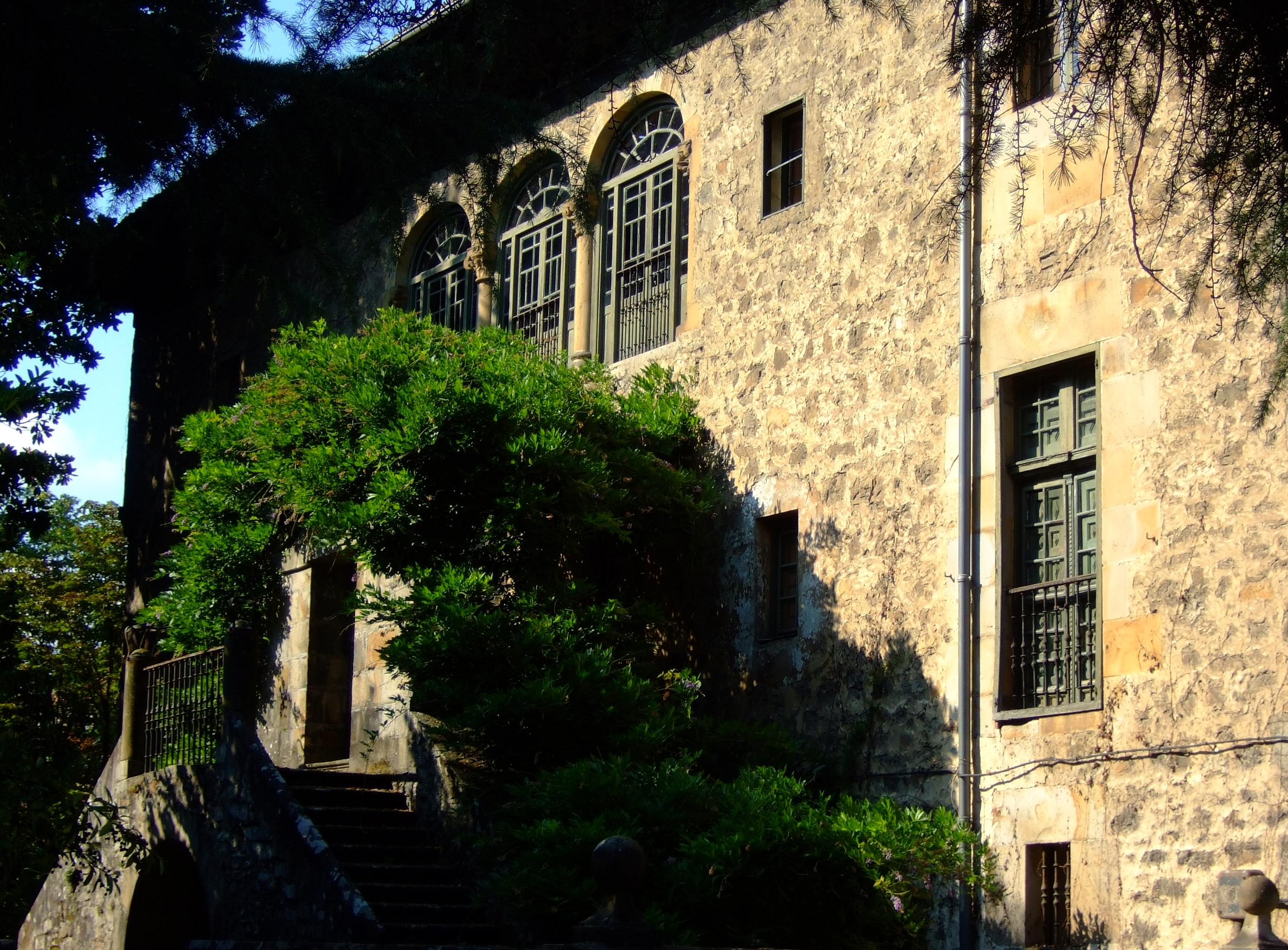Me resulta casi imposible pensar en Vergara sin evocar al instante la curiosa expresión con que Valle-Inclán solía aludir a los acontecimientos históricos que allí ocurrieron; expresión que, en mi fantasía, venía como envuelta en el misterio y formando parte de las ya misteriosas (por periféricas y secundarias) guerras carlistas. “La traición de Vergara”, decía el escritor. ¿Qué traición había sido esa? La suponía yo íntimamente ligada al pacto del mismo nombre, pero ¿a qué se refería exactamente Don Ramón? Y he de confesar que el aprendizaje in situ de la historia relacionada con tal ciudad ha sido lo que esta vez, más que el placer de darme un garbeo en moto, me ha impulsado a ponerme en marcha.
El día ha salido perfecto: cálido, soleado y con poco viento. Una maravilla para el motero. La carretera provincial hasta Escoriaza es una gozada de buen asfalto y ágiles curvas, idóneas para probar la destreza propia con cierto gusanillo en el estómago. Luego, al paso por las zonas industriales de Arechabaleta y Arrasate, la ruta se afea un poco. En tres cuartos de hora, casi sin darme cuenta, estoy ya cruzando el puente del Deva, y enseguida me planto en pleno centro de Vergara, frente al casco antiguo. Pasa ya del mediodía y va apretando un poco el sol, así que dejo la moto a la sombra y empiezo a caminar, guiado sólo por el mero capricho. Quiere la casualidad que lo primero que llame mi atención sea el escudo en esquina del sobrio palacio Irizar, precisamente donde en 1839 los generales Maroto y Espartero firmaron el famoso convenio que puso fin a la primera guerra carlista.
Siempre atraído por la solemne belleza de los edificios antiguos, me acerco hasta el palacio sin saber aún lo que representa y, encontrando abierta la recia puerta de doble hoja, traspaso su umbral. Me hallo en un amplio y fresco zaguán de añejo suelo empedrado y austeras paredes, que sólo alberga una mínima exposición con unos grandes murales en que se cuentan, de una parte, la historia del edificio y, de otra, junto a dos reproducciones tamaño natural de los generales Baldomero Espartero y Rafael Maroto, las circunstancias en las que tuvieron lugar el convenio y el abrazo de Vergara. Me adueño del último folleto informativo que queda en español (los ejemplares en vascuence se aburren en su cajetín, atestiguando un deseo político) y, según visito el resto de la ciudad, voy leyendo en él los acontecimientos que la hicieron famosa; aunque no sin dificultad, pues el folleto, al intentar conciliar el rigor histórico con el dogmatismo identitario, resulta tibio y poco didáctico.
A poco que doy unos pasos por las calles del casco viejo me veo en la amplia plaza del ayuntamiento, frente a cuyo blasonado edificio se levanta otro, uno de los más emblemáticos y de mayor relevancia histórica en la ciudad: el Real seminario, sede que fue de la Real sociedad vascongada de Amigos del país, y originalmente un colegio de la Compañía de Jesús. Al ser expulsados los jesuitas de España, la Sociedad pidió gracia al rey para utilizar el edificio, y le fue concedida.
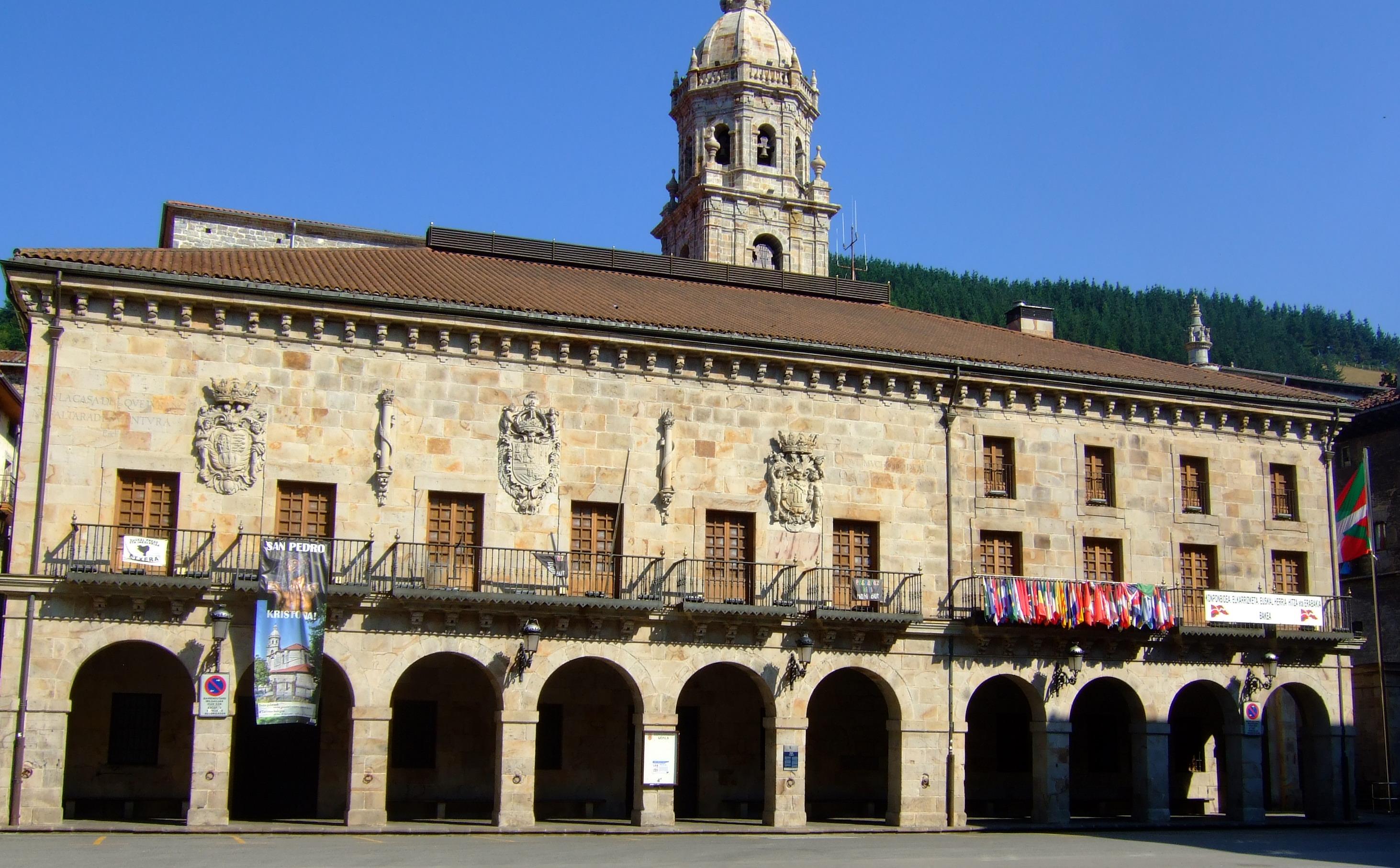
Ayuntamiento, con muchas banderas para camuflar la española. Por detrás asoma la torre de la Iglesia.
Esto ocurría en la época de mayor auge económico de la villa, una vez que cesaron las escabechinas en que, durante dos siglos, se habían enfrentado sus familias y barrios rivales. Con la paz, vino la prosperidad a Vergara entre los ss XVI y XVIII, primero como mercado agrario, luego como enclave industrial ligado al hierro y, posteriormente, a partir de la creación de la mentada Sociedad, también como centro cultural. Fue durante esa época de relativo esplendor cuando en el Real seminario se descubriría el wolframio.
Justo detrás del ayuntamiento se yergue, majestuosa y recia, la parroquia de San Pedro de Ariznoa, de antiquísimos orígenes y verdadero embrión de la población de Vergara. En efecto, poco más que una ermita con ese nombre debió existir en estas tierras antes de que Alfonso X, en 1268, dispusiera la creación de la villa “a fuero de Vitoria”, llamándola Villanueva de Vergara. Así reza el documento:
“…Que habemos de facer una puebla en Vergara, e señaladamente en aquel logar que dicen Ariznoa; a que ponemos nombre Villanueva, e por facer bien e merced a los pobladores que agora son e seran daqui adelante, damosles e otorgamosles el fuero que han los de Vitoria.”
A este fuero sucesivos reyes añadirían otros privilegios con el interés de que la villa se poblase mejor.
Por tanto, a semejanza de otras localidades vascas de mediana importancia, Vergara nace en el seno de Castilla y sólo a esta corona (salvo después a la española) ha pertenecido en la historia. No hay, pues, fundamento alguno para su inclusión en territorios que hoy reclaman la independencia histórica. (Es de señalar, por cierto, que Vergara siempre se escribió así: con uve, y que el actual nombre oficial Bergara, con be, no puede responder más que a una artificial “euskaldunización” -si se me permite la palabra- de corte político.)
Observo la iglesia y, pese a la elegancia de su relativamente moderna fachada sur, escudo nobiliario incluido, me gusta bastante más su pórtico lateral oeste -otrora entrada principal- con ese romántico aire medieval que le confieren las sombras, las columnas de madera y los peldaños desgastados; pero más aún me atrae, cuando doblo la esquina con curiosidad infantil, el estrecho, húmedo y frío callejón porticado del flanco norte; y al caminar una docena de metros a lo largo de su pared hay una puerta abierta al interior de la parroquia, que aparece por completo sumida en las tinieblas. Una abertura que parece absorberme con una fuerza que no puedo resistir.
Sigiloso y obediente, entro en la iglesia con reverencia y expectante curiosidad, como quien traspasa el umbral hacia otro mundo. Me hallo sumergido en una total oscuridad que mi vista tarda unos segundos en comenzar a penetrar. Cuando las tinieblas se aclaran un poco, veo que estoy junto en una nave lateral de la iglesia, paralela a la central. A mi izquierda, un rectángulo lechoso en la oscuridad denuncia la existencia de una puerta medio entornada; quizá hacia la sacristía. Frente a mí, la nave principal aparece inmersa en una difusa luz grisácea, muy tenue, cuyo origen no puedo precisar. A mi derecha, resguardados de esta mínima claridad por el suelo del coro y por los gruesos pilares del edificio, hay unos bancos sumidos en la mayor de las penumbras. Con gran lentitud, voy buscando mi camino a tientas para sentarme en uno de ellos; y la madera, al sentir mi peso, emite un pequeño crujido que resuena en el silencio absoluto.
¿Absoluto? No tanto. A medida que mis ojos y oídos se acostumbran a esta oscuridad y quietud empiezo a percibir un tenue murmullo y unos levísimos susurros ocasionales. Veo unas formas silentes moverse en las sombras y, frente al altar, un cuerpo arrodillado, cubierto por un hábito, que de vez en tanto hace una reverencia. De ahí provienen los murmullos. ¿Y los susurros? Son el frufrú de los hábitos que visten unos seres con apariencia angelical, que se desplazan sin apenas rozar el suelo, sin ruido de pasos, y que evolucionan por la iglesia con movimientos que parecen estar guiados por hilos desde las altas bóvedas. Aparecen o desaparecen por la puerta de la sacristía haciendo labores varias en completo silencio, cambian las flores del altar, limpian el polvo del retablo, llenan de agua los benditarios. O entran y salen por la misma puerta que utilicé yo. Me siento como si fuera un viajero en el tiempo observando desde una burbuja invisible las escenas del pasado. Una de esas formas levanta su rostro hacia mí y parece mirarme, como si pudiera traspasar la opacidad de la negrura a mi alrededor. Es una mujer joven, grácil, quizá incluso hermosa. Luego continúa su cometido, cualquiera que sea.
Permanezco ahí largo rato, disfrutando de un sosiego espiritual, sintiéndome a salvo de los peligros y las preocupaciones del mundo exterior. Es como haber entrado en un lugar encantado, donde habitan la paz, el silencio y las sombras. Me parece formar parte de ese lugar, estar integrado en la madera y la piedra. Una experiencia casi mística.
Cuando salgo hacia la luz y hacia la vida, un impulso me hace seguir la pista de una de las religiosas. Por el camino me cruzo con otra, también joven, que me lanza una fugaz mirada con una leve sonrisa en los labios. Los pasos de aquélla me llevan hasta la puerta del vecino y secular monasterio de la Santísima Trinidad. Son hermanas Clarisas; o quizá sólo beatas
Un exhaustivo recorrido por las callejuelas del casco viejo me brinda la ocasión de contemplar una abundancia de casas nobles, blasonadas, elegantes e incluso suntuosas, que atestiguan la eficacia que, para poblar la villa, tuvo la concesión de privilegios a los “fijosdalgo” que en ella se estableciesen.
A diferencia de otras fundadas en la misma época del medievo, con idénticos objetivos de afianzar fronteras y expandir el comercio, Vergara no fue amurallada; lo que no significa que fuese un ejemplo de paz, ya que durante los ss XIV y XV se libraron en sus calles las batallas de una continua contienda entre bandos, integrados por los distintos barrios o aldeas que la componían, y continuación en buena medida de las rivalidades ancestrales entre las familias Ozaeta y Gabiria.
Con la energía de un chaval que explora por vez primera un castillo, subo las empinadas cuestas que, detrás de la ciudad, llevan hasta el antiguo convento de la Soledad, desde donde se dominan los tejados de toda la villa y el cauce del Deva. Frente al convento hay un parche de hierba y un frondoso árbol de fresca sombra, bajo cuyas hojas descanso un rato del esfuerzo de la subida, porque chaval ya no soy. Es este un lugar idílico que, como tantos otros en el País Vasco, parece haber quedado trabado en los espinos del tiempo.
Desde aquí, bajo a la fresca y arbolada orilla del Deva, no sin echar un vistazo a Rosaura, que sigue intacta y a la sombra. Desde uno de los puentes del río se divisa, en contraste con el bosque de la ladera, la parroquia de Santa Marina, testigo del famoso abrazo entre los dos ejércitos combatientes.
Me encamino hacia allí, para hollar con mis propios pies el escenario de aquel encuentro… o de aquella traición.
En la primera mitad del s XIX la prosperidad que disfrutaba Vergara, reflejada en la abundancia y riqueza de sus palacios y edificios, se interrumpió al verse la villa involucrada en las guerras carlistas y ser escenario de algunos de sus principales acontecimientos. Cuenta la historia que, a la muerte de Fernando VII, la región se encontró dividida entre los liberales, partidarios de su viuda la regente Cristina, y los carlistas, en apoyo de su hermano el príncipe Don Carlos. Fiel en una primera batalla al bando liberal, la Vergara no tardaría, sin embargo, en rendirse sin resistencia a los carlistas, quedando bajo el mando del general Maroto. Sin embargo, a medida que los liberales fueron avanzando en otros frentes y que las calamidades (hambre, enfermedades, inundaciones) se adueñaban del pueblo, empezó a plantearse la conveniencia de llegar a un acuerdo que pusiera fin a esa guerra fratricida y la miseria que acarreaba, de modo que se estableció el diálogo entre los generales de ambos ejércitos que batallaban en la región, y que finalmente acordaron el mentado pacto, en virtud del cual los carlistas rendían sus armas al general Espartero a condición de que la corona respetase sus fueros, que la regente quería abolir. Y este acuerdo, firmado en el palacio Irizar como queda dicho, fue sellado y escenificado públicamente con el abrazo de ambos generales a las afueras de la villa, junto a la iglesia de Santa Marina.
Tal es el acuerdo al que Valle-Inclán, o acaso sólo alguno de sus personajes, se refiere como la traición de Vergara, al entender que la causa carlista fue de esa forma traicionada. Queda por fin, gracias a esta visita, aclarada la incógnita que para mí encerraron durante años las palabras del escritor gallego, y disipado el simple misterio que contenían.
Cumplida la misión, ya sólo me resta volver. Pero antes, como es mi costumbre, busco un lugar agradable donde pedir vino y pincho. Lo encuentro en la casa de Aróstegui, donde devoro con fruición un sector de tortilla, sentado a una mesa bajo la sombra de un frondoso árbol. Esta vez, para variar, he pedido una pepacola. Desde donde estoy puedo ver la moto, que espera ser cabalgada pronto.
Hay, en el extremo oeste del campo del abrazo, un palacio llamado Laureaga, mandado construir en el s XVI por el linaje Izaguirre, quienes hicieron inscribir en la reja de una de sus ventanas la siguiente inscripción: “Ni la busques ni la temas”. Se refiere a la muerte. Sabio lema bajo el que vivir… si se es capaz de ello.I can hardly think of Vergara without at once evoking the strange expression used by Valle-Inclán–one of my favourite Spanish writers– to refer to the historical events that took place in such town. I used to think of these words as coming wrapped in some kind of mistery within the misterious Spanish side-wars called Carlistas. “The betrayal of Vergara”, wrote Valle-Inclán. What betrayal was that? I guessed it must be connected with the agreement of Vergara, but what did the writer exactly mean? Thus, this time I took a ride there for learning about those facts in situ, rather than for just the pleasure of riding.
Besides, the day comes perfect for the motorcycle: warm, sunny and not windy. Wonderful for a biker. The first half of the ride, until Escoriaza, goes on a pleasurable pavement and along fun bends, great for testing one’s ability; but the second half isn’t that nice, running through the industrial areas of Arechabaleta and Arrasate.
Before almost realizing it, I’m already crossing over the Deva river and arriving to the city centre of Vergara, right by the old town. It’s past noon, and becoming a bit hot. I park Rosaura well in the shade and start a stroll along the town. By pure chance, the first thing calling my attention is the corner-crest of the sober Irizar palace, precisely the house where generals Maroto and Espartero signed the famous agreement which, in 1839, ended the first Carlista war.
But supposedly I still don’t know about that; so, I walk to the palace attracted, as usual, by the solemn beauty of ancient buildings. The double-leaf gate is open, and across it there is a smal yard, cobbled, holding a succint exhibition where the history of the building is told on big posters, and the circumstances under which the agreement and the embrace of Vergara took place are explained. I pick the last brochure in Spanish (the copies in Basque sleep in their box, evidencing that a bilingual Basque country is more a wish than a reality) and, while sauntering along the borough, I read the events that made a historical landmark of it. Tough task, though, as the brochure tries to harmonize historical accuracy and independentist dogmatism, thus being tepid and barely informative.
A couple of blocks further, I run into a wide square having on one side the excessively emblazoned city hall and, on the other, one of Vergara’s most important and historically relevant buildings: the Royal seminar, seat of the Royal Basque society of friends of the land, formerly a school belonging to the religious order Compañía de Jesús, thrown out from Spain by the king.
Thi seminar was founded during the splendour of Vergara, after the end of the struggles which, for two centuries, upheaved the town, having confronted rival families and neighbourhoods. Along with the peace, prosperity came and stayed between XVIth and XVIIIth centuries, firstly as an agricultural market, then as an industrial settlement and, finally, thanks to the seminar, as a cultural centre. It was here where the chemical element Wolframium was discovered.
Right behind the city hall stands, majestic and sturdy, the ancient parish of San Pedro de Ariznoa, the real germ of Vergara. Indeed, little more than a chapel must have existed in these whereabouts before Alfonso X, in the year 1268, decreed the foundation of a borough, with privileges alike those of Vitoria and named Villanueva (of Vergara). Thus reads the document:
“…We must create a borough in Vergara, namely in such a place called Ariznoa, and We name it Villanueva, and in order to do good and favour to the present and to-be settlers, we grant them the same privileges as those of Vitoria.”
Upcoming kings added new privileges to the borough for achieving a faster populating.
Thus, and like other Basque towns, Vergara was born under the rule of Castile, and to Castile only (except later to Spain) has it ever belonged along History. Therefore, there are no grounds whatsoever for being included in the territory that, today, claims their independence upon historical basis. (Mark, btw, that Vergara has always been written as such: with V, and that the present official name of Bergara, with B, has the sole political purpose of artificially “Basqu-izing” it.)
I watch the parish from outside and, despite the elegance of its South facade, coat of arms and all, I like better its West side portico (once main entrance), with its romantic medieval look bestowed by the shades, the wood posts and the worn steps. Yet, I like even better the narrow, wet and cool porched alley of the North side. And walking along this side I find a by-door leading to the church’s gloomy inside.
Inside San Pedro of Ariznoa.
Such black opening seems to attract me with a force that I can’t resist. Obedient, full of curiosity and awe, I stealthily set foot inside the blackness as if crossing the threshold to another world. Once in, I face total darkness, which my eyes need some time to pierce through. When the thick shadows thin out a bit, I see that I’m within a side nave, only a few feet away from the main one. Some metres to my left, in the middle of the shapeless nothingness, there is the milky rectangle of a door ajar leading somewhere, maybe to the vestry. Right ahead of me, the main nave’s vault appears soaked in a dim greyish light, quite faint, whose origin I can’t tell. To my right, shielded from any light whatsoever by the choir’s floor above and one of the church’s thick pillars, there are a few benches submerged in the thickest blackness. Slowly and carefully, I grope my way along and sit on a bench. Upon feeling my weight, a creak of the wood fills in the utter silence.
¿Utter? Not quite. As my eyes and ears get used to this gloom and quietness, I start perceiving a faint, constant murmur and a some feeble chance whispers. Now and then, I see noiseless figures moving in the shade. In front of the altar, a kneeling body under a robe bowes once in a while. Thence the murmur. And the whispers? They’re the rustle of the habits of angelic-looking beings which go about barely touching the floor, apparently footstepsless, moving back and forth as puppets whose threads came down from up the dome. I see them getting in or out through the vestry door, and performing various tasks in complete silence: change the flowers, dust the altarpiece, fill in the holy water basins. Or they come in, or leave, through the same gate I used.
I feel as a time-traveler, watching scenes of the past from within an invisible bubble. Then, I fancy that one of those figures lifts her face and stares at me, as if she could pierce the blackness’ opacity whereof I’m wrapped up. She’s a young woman, graceful, maybe even pretty. Then she goes back to her job, whichever it is.
I remain sitting here for a while, enjoying a spiritual composure, safe from the dangers and worries of the outer world. It’s like if I had entered an enchanted place, where peace, silence and shadows dwell, and I feel part of such place, blended with the wood and the stone. An almost mystic experience.
When I come out to life and light, I try to follow the track of one of those angels. Along the way, I run into another one, which throws at me a quick glance and a faint smile. She’s also young. They can’t possibly be nuns. Maybe lay sisters? Nearby there is the ancient monastery of the Holy Trinity, where the Clarisas sisters abide.
A thorough tour along the old town’s streets gives me the chance of beholding plenty of noblemens’ emblazoned palaces, elegant and even luxurious, evidencing that the grant of privileges to the noblemen for settling in Vergara was quite effective for populating the village.
Unlike other medieval boroughs founded during the same time and with similar purposes (border strenghten and commerce expansion), Vergara was never walled up–which doesn’t mean it was a peaceful town: along XIVth and XVth, frays were fought continually on the streets out of a long faction war, held between districts and, oftentimes–like Shakespeare’s Capulets and Montagues–between families, namely the Ozaetas and the Gabirias.
With the energy of a kid visiting a castle for the first time, I climb up the steep backstreets which lead to the ancient Nunnery of La Soledad, from where you can look out over the whole village’s roofs and Deva’s riverbed. Right in front of the nunnery’s facade there is a grass patch under a leafy tree, where I take a little rest, as I’m no kid any more. What an idyllic place! Like many other in the Basque country, it seems to have got tangled in the thorns of time…
Then, I go down from here to the cool and wooded Deva bank–first taking a look at Rosaura, who waits for me sound safe in the shade. From one of the Deva’s bridges I can see, contrasting with the woody background, the Santa Marina parish, witness of the famous embrace between the two confronted armies.
I head that way with the aim of treading with my own feet on that meeting’s–or that betrayal’s scene.
Indeed, during the first of XIXth century, Vergara’s prosperity, evidenced by the many rich palaces and buildings, was hampered when the town got involved in the Carlistas wars and became main scene for some of its events. History goes that, after Fernando the VIIth’s death, this region was split between liberals (supporting his regent widow Cristina) and the carlistas (backing up his brother, prince Carlos). Vergara was first loyal to the former, but soon surrendered to the latter without resistance, and passed under the command of General Maroto. However, as liberals were moving forward in other fronts and as hunger, disease, floods and other calamities fell upon Vergara, it was deemed convenient to reach some agreement to put an end to such fratricidal war. To this end, conversations started between both armies’ Generals, who finally agreed on the aforementioned agreement, hereby carlistas must reverse their weapons under condition that the Crown would respect their privileges, which the regent wanted to revoke. And this agreement, after having been signed in the Irizar palace as told, was publicly sealed and “dramatized” by both generals embracing each other on the outskirts of town, beside Santa Marina church.
And this is the pact to which Valle-Inclán, or maybe just one of his characters, refers to as the betrayal of Vergara, in the belief that the Carlista cause was thereby treasoned. So, thanks to this tour, the mystery has finally vanished around the writer’s words, for me. Mission accomplished, I needn’t but go back home. Not before having my customary drink and pincho in some pleasant bar, though. Aróstegui house is the place, where I wolf down the pincho de tortilla while drinking a coke sitting at a table under a leafy tree in the sleepy afternoon.
On the field of embrace’s West end stands a palace now owned by Laureaga lineage, but built by the Izaguirres during XVIth century, who set that on the bars of its lower window this inscription should be engraved: “Neither seek it nor dread it”; meaning death. Wise motto to live by, if you’re able to.

